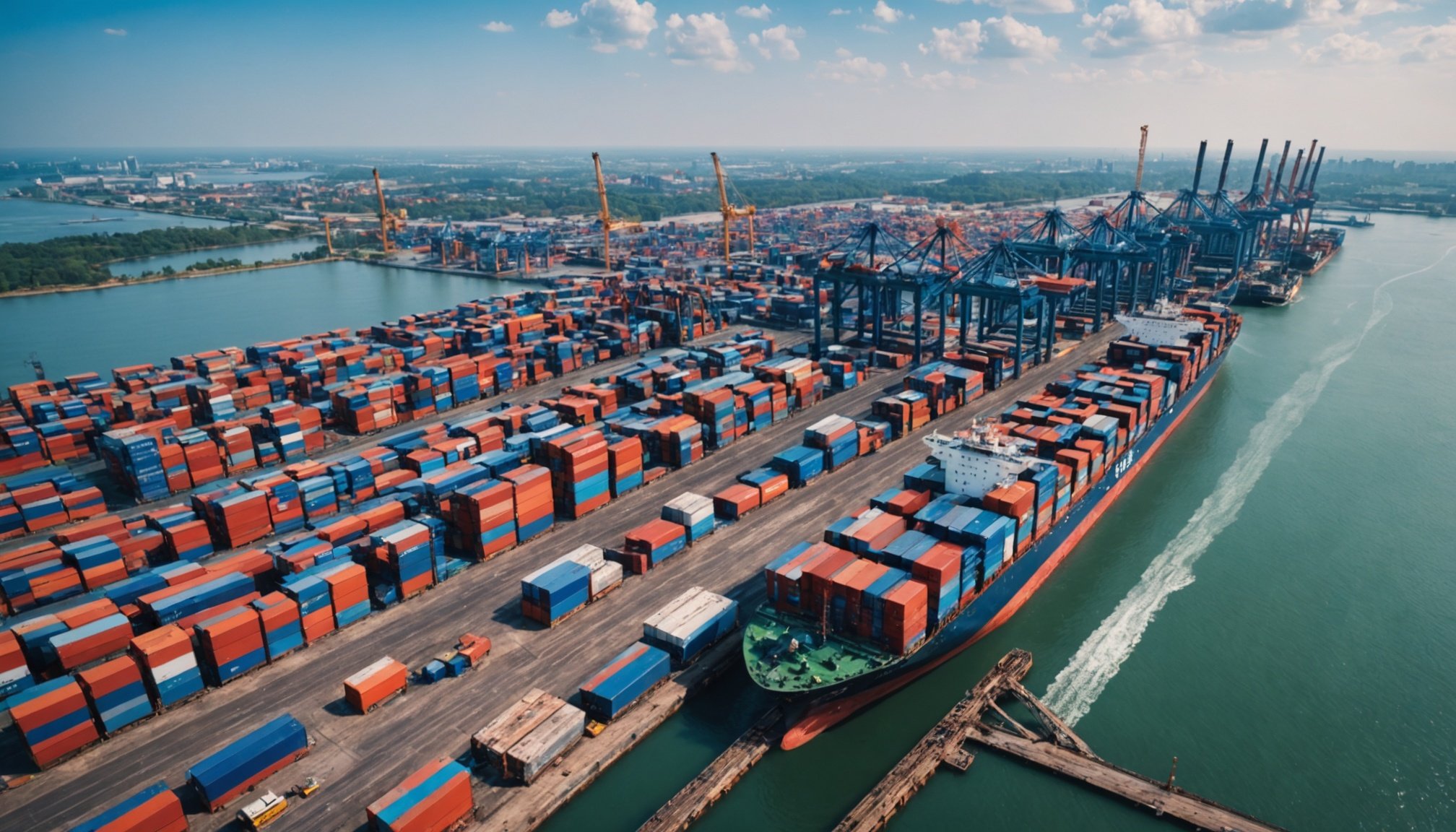Overview of AI-Driven Predictive Analytics in Supply Chain Management
AI predictive analytics has emerged as a transformative force in supply chain management, enabling companies to anticipate future needs and streamline operations. By harnessing vast amounts of data, these analytics help organizations make more informed decisions, leading to enhanced logistics innovation.
The core of AI predictive analytics lies in its ability to predict outcomes using algorithms and machine learning. These methodologies enable companies to analyse patterns and trends, thus making it easier to mitigate potential risks. Technologies such as neural networks and natural language processing are key components, driving a deeper understanding of complex data sets.
Also read : Empowering AI: Crafting a Robust Network for Thriving Critical Infrastructure
As businesses aim to stay competitive, the adoption of AI-driven analytics continues to rise. Presently, many sectors are experiencing a shift towards integrating these technologies, evidencing a broader trend toward AI utilization. However, varying degrees of adoption exist across different industries, with some sectors more advanced in applying these innovative solutions.
It is vital to recognize the importance of AI predictive analytics. It not only optimizes resources and reduces operational stress but also sets the stage for continuous growth and advancement in modern supply chains. The evolving landscape points towards greater adoption, exploring untapped potentials in logistics and beyond.
Additional reading : Transforming Aviation: Harnessing Cutting-Edge AI for Enhanced Predictive Maintenance Solutions
Current Applications of AI in Supply Chain Management
The integration of AI applications into supply chain management has revolutionized the landscape of logistics optimization. By harnessing these cutting-edge technologies, businesses enhance supply chain efficiency and sustain a competitive edge.
Demand Forecasting
AI plays a crucial role in demand forecasting, enabling precise predictions by analysing historical sales data, market trends, and consumer behaviours. Retail giants, for instance, utilize AI to adjust stock levels accurately, preventing stockouts and overstock situations.
Inventory Management
AI advances have significantly impacted inventory management. Automation tools powered by AI streamline inventory tracking, reduce errors, and optimise storage costs. With real-time data, companies can swiftly respond to changes in demand, achieving better resource allocation.
Transportation and Distribution
In transportation and distribution, AI applications provide substantial benefits. Real-time route optimization algorithms enhance delivery efficiency, reducing transit times. This not only results in cost savings but also improves customer satisfaction through timely deliveries.
AI applications in these areas not only drive logistical innovations but also fortify operational efficiency across various sectors. By continuing to adopt these technologies, businesses can unlock further potential in their supply chain processes. AI’s role in shaping a resilient, responsive supply chain system is irrefutable, marking it as an indispensable component of modern logistics.
Benefits of Implementing Predictive Analytics
Implementing predictive analytics in supply chain management offers a multitude of analytics benefits, revolutionizing operational efficiency and driving substantial cost reduction. By leveraging data-driven technologies, companies can enhance resource allocation, ensuring optimal deployment of assets and minimizing waste.
A key advantage is the significant impact on cost savings. Through predictive models, organizations anticipate demand fluctuations, allowing more precise inventory control and reducing the expenses associated with overstocking or stockouts. This improved resource management directly translates to financial gains and streamlined operations.
Furthermore, predictive analytics elevates customer satisfaction by refining delivery processes. With precise forecasting, companies optimize logistics, leading to faster, more reliable delivery. As a result, customer trust and loyalty are bolstered, providing a competitive edge in the market.
Another critical benefit is risk management. Predictive analytics enables companies to identify potential disruptions in the supply chain, such as delays due to external factors or sudden demand spikes. Addressing these risks proactively fosters a resilient supply chain, maintaining service continuity and establishing a robust reputation.
Data-driven decision-making establishes a culture of informed operations, equipping organizations to tackle future challenges effectively. In this rapidly evolving landscape, adopting predictive analytics becomes indispensable for businesses aiming to sustain growth and innovation.
Challenges in Adopting AI-Driven Predictive Analytics
Implementing AI-driven predictive analytics in supply chains comes with its share of implementation challenges. One major barrier is data quality. Companies often struggle with incomplete, inconsistent, or outdated data which hampers accurate predictive outcomes. Ensuring data integrity is crucial for reliable analytics and demands rigorous maintenance and verification processes.
Additionally, integrating new analytics systems with existing infrastructure presents challenges. Many organizations face issues with system compatibility, necessitating careful planning to synchronize old and new technologies. This integration often requires a shift in organizational processes, which can be both time-consuming and resource-intensive. Solutions include phased integration approaches and utilising robust middleware systems that bridge technological gaps.
The skills gap in the workforce is another significant hurdle. Employees need training in both the use and interpretation of AI analytics tools to fully leverage their potential. Investing in comprehensive workforce development programs and ongoing educational initiatives is essential.
Organizations that successfully address these challenges often adopt strategies such as investing in state-of-the-art data management solutions, creating collaborative environments for cross-departmental learning, and employing expert consultants to guide the transition. By overcoming these hurdles, companies can unlock the full potential of predictive analytics, ultimately enhancing supply chain resilience and efficiency.
Case Studies: Success Stories in AI-Driven Analytics
AI-driven analytics has paved the way for impressive transformations in global logistics, exemplified by numerous success stories. In the retail sector, companies like Walmart have leveraged AI to refine demand forecasting, exemplified by a 30% reduction in stock-outs. AI-driven predictive models enabled accurate demand forecasts by analysing vast datasets of consumer behaviour and sales trends.
The auto industry also showcases AI’s impact, notably in BMW’s supply chain. Here, AI optimizes production schedules and inventory management, leading to a 20% increase in overall efficiency. Advanced algorithms help dynamically adjust inventory levels based on real-time demand, reducing excess stock and improving resource allocation.
In the tech industry, IBM’s use of AI analytics for logistics optimization highlights substantial improvement. Through machine learning models, IBM significantly reduced delivery times, enhancing customer satisfaction. This strategic implementation also fostered proactive risk management by predicting supply chain disruptions and swiftly addressing them.
Key lessons from these case studies include the value of data integrity, strategic tool selection, and workforce training. By aligning strategy with AI capabilities, these organizations achieved notable logistics transformation. They set benchmarks for industries aiming to integrate predictive analytics effectively.
Future Trends in AI-Driven Predictive Analytics
The landscape of predictive analytics trends in supply chain management is poised for significant transformation. As businesses strive to heighten future logistics capabilities, the technology evolution in AI presents new frontiers.
Emerging Technologies
Emerging technologies are reshaping how companies deploy predictive analytics. Quantum computing and advanced AI algorithms are at the forefront, offering unprecedented processing power and precision in predicting supply chain dynamics. These innovations enable deeper analysis with more complex datasets, enhancing accuracy and responsiveness to market changes.
Potential Innovations in Data Utilization
In terms of data utilization, companies increasingly leverage connected devices and IoT sensors to gather real-time operational insights. This data-rich environment facilitates proactive decision-making, allowing companies to anticipate disruptions before they impact the supply chain. It enables seamless communication across logistics networks, optimizing resource use through data-driven insights.
The Role of Sustainability
Sustainability is becoming a critical consideration in predictive analytics. AI helps develop strategies that align with environmental goals, reducing carbon footprints through optimized route planning and resource allocation. Predictive analytics supports sustainable supply chain practices by focusing on efficiency without compromising environmental integrity, a growing priority for businesses worldwide.
Actionable Strategies for Implementing Predictive Analytics
Implementing predictive analytics in supply chain operations demands strategic planning to achieve optimal logistics efficiency. Here’s a step-by-step guide to integrating these innovative techniques:
-
Assess Current Systems: Begin with a thorough evaluation of existing supply chain processes. Identify inefficiencies and areas where predictive analytics could lend insights.
-
Select Appropriate Tools: Choose technologies and tools that align with your organizational needs. This selection should be based on the specific requirements, such as real-time data access or machine learning capabilities. Consult with experts and consider trials before full-scale adoption.
-
Integrate and Customize: Customize the AI solutions to fit perfectly within your current infrastructure. This step involves data mapping and ensuring system compatibility to avoid disruptions during the transition phase.
-
Train Workforce Effectively: Equip employees with comprehensive training programs. Understanding how to utilize and interpret analytics tools is crucial for maximizing their utility.
-
Monitor and Adapt: Establish a feedback loop for continuous evaluation. Regularly review performance metrics to adapt strategies in response to evolving supply chain demands.
By following these strategies, organizations can unlock the transformative potential of AI-driven analytics, enhancing both efficiency and accuracy in supply chain management.











